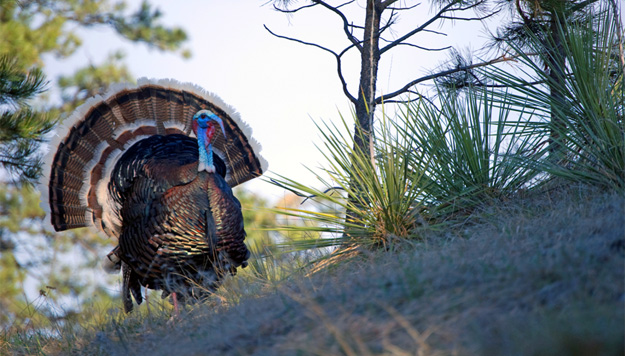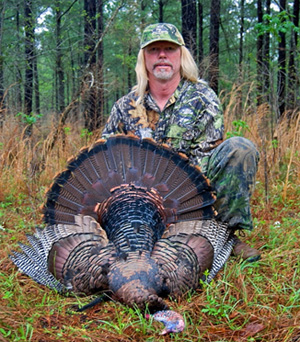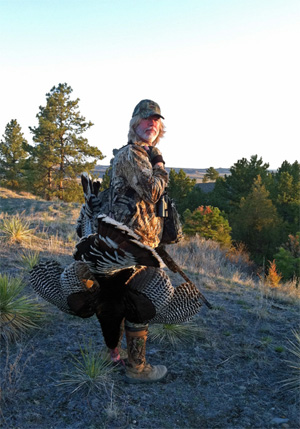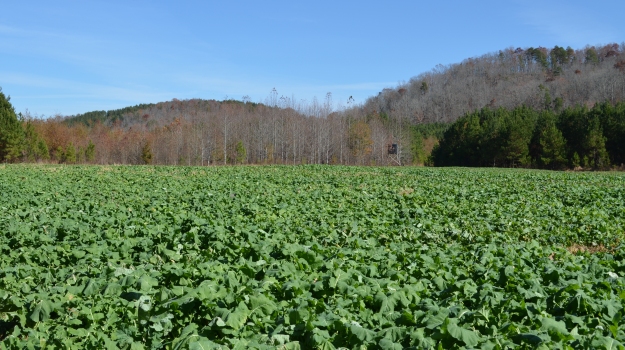By Bobby Parks

Read Part 1 here.
Field Hunting
Open areas such as pastures and fields are great places to find birds and can be especially good on rainy days. When approaching fields, I use cover and terrain to slip up to view the field. I may not cut or call with a turkey call as I approach, but will blast them with a crow call in an effort to shock one into sounding off. I’m not counting on this as a for sure way of knowing they’re there as gobblers sometime seem to have gone deaf for periods of time and don’t gobble at anything. But it is a way to attempt to find him without worrying about him starting towards me quietly while continuing to move towards the field. The last thing I want is to call and cause the bird to focus in my direction, start approaching me quietly or bump into him when I’m out of position. My preference is to sneak up close enough to glass the field with a plan of maneuvering around and setting up if I see birds.
If none are there but I know it’s a good spot and it’s just a matter of time, I’ll dig in by making a makeshift blind. I stay in the shadows and commit to a position for varying periods of time. If visibility and cover provides, I like to back off a field 10-15 yards so that a bird has reason to search for me. It also helps with getting hens by un-spooked and if a gobbler approaches tight down the edge, I can move and get away with it compared to actually sitting right on the field.
If you’re using decoys, set them up 10-15 yards out into the field (20-25 yards away from you) and often times if you snooze that’s where the gobbler will be when you wake up.
 Anyone that’s hunted field birds knows how tough and stubborn they can be. You can spend hours just watching a bird that feeds and shows little interest. Once a gobbler’s in the field, I call soft and very little unless he was responding to other calling I was doing, which I would then continue. It depends on how he reacts. If he’s feeding and not interested, I play it safe. Although I have had luck pulling birds across fields with fighting purrs as well.
Anyone that’s hunted field birds knows how tough and stubborn they can be. You can spend hours just watching a bird that feeds and shows little interest. Once a gobbler’s in the field, I call soft and very little unless he was responding to other calling I was doing, which I would then continue. It depends on how he reacts. If he’s feeding and not interested, I play it safe. Although I have had luck pulling birds across fields with fighting purrs as well.
I also start looking for a way to move around on him, if he shows patterns of moving back and forth and hanging on one side of the field. If I see a way to move around and re position, I’ll go for it. Just calling from a different location sometimes makes a difference. So even if I can’t make a big move, a short move of 20-50 yards towards him can make a difference. Just know that often on a field that is known to be used by birds you can bump others by trying this. It’s a judgment call and often based on hunches. Sometimes it’s due to impatience.
Calling Sequence
Generally, I’ll go through a calling sequence every 15 minutes starting soft and easy with clucks and soft yelps. I’ll then work up to more aggressive calls. Opinions vary on this and I agree that you’re probably safer by keeping it soft and easy and calling every 15-20 minutes. It’s not always about being safe for me and I like to call. I want any bird within 250 yards to know I’m there. I’ve had good luck though the years by not being afraid to crank and let birds know some odd ball loudmouth hen is in the woods while all the other self-respecting hens are just purring and minding their own business. The exception is if I really believe birds are imminent or close, in which case I’ll control my tempo and exercise more patience.
I can remember many days where I sat for 2-3 hours going through 10-12 calling sequences, hearing nothing and thinking it’s just not going to happen today only to be startled by a gobbler cutting me off when I called. If this happens, he’s most likely coming in. On other hunts, I’ve had gobblers gobble and announce their arrival 10-15 minutes after calling. He heard me and locked in on my position when I called earlier and is letting me know he is close to where he thought the hen should be. Consider this a lucky break but it happens often enough.
On the opposite side, I have called from a spot for an hour or so, got up and walked off only to hear a bird gobble from the spot I just left 10 minutes later. Not a good feeling.
Once a bird is in sight, it really does vary and it comes down to watching and reading the bird. Taking the gobbler’s temperature factors in to an extent but soft and easy once he’s in tight is the way to go, if you have to call again at all. If he’s come because of your previous calling, he may continue to wander into your lap. Just watch him and see what he’s going to do on his own. Even scratching on the leaves can coax him on over into range. Often a gobbler during the early to mid afternoon periods seem to have a “take it or leave it” attitude. This gets progressively better as the afternoon goes on and towards late afternoon to evening they can be as hot as in the mornings.
There are other options to consider as well. For example, if I hear a bird sound off at longer distances while I’ve been in a set up for a while, I may jump and run towards him but often I give him a few minutes and call again to see if he will gobble again and to see if he was gobbling at me. If it sounds like he’s closed the distance, I may stay or move forward depending on terrain and my hunch. He may very well come all the way in but if I can cut some distance off by charging forward and sitting down again and calling, it can only help as long as you don’t get busted. It will appear to him as if the hen is coming towards him and may fire him up more.
If I happen to know there’s a distant obstacle such as a creek or fence in the direction he gobbled from, then I’m going to make an aggressive move to get to that spot before he does.
Late Afternoons
My experience in afternoons, at least where I’ve hunted Easterns, is almost no gobbling occurs until after 5. My attitude and enthusiasm picks up accordingly as the day wears on. I may have set up in a particular area for specific reasons for mid-day hunts and relocate to put myself in a general roosting area or travel route for late day set ups. I want to be within hearing range of any known roosting locations, but not pushing the limit to the point I change their habits if a bird busts me. That said, I am not beyond getting in tight on a roost if I’m traveling and I’m running out of time. It depends on how badly I want a bird. Many argue against this and I believe it depends on circumstances and properties.
 For example, in Texas there are places that many birds will roost night after night. To get in tight and cause a scene would change their habits and make them harder to hunt on following days or for future hunters. I avoid pushing too hard there. If there are such places that are known on your hunting properties to be consistently holding roosted birds, it is a good idea to give them somewhat of a berth so that you’ll know where to get after them on morning hunts at least early in the season.
For example, in Texas there are places that many birds will roost night after night. To get in tight and cause a scene would change their habits and make them harder to hunt on following days or for future hunters. I avoid pushing too hard there. If there are such places that are known on your hunting properties to be consistently holding roosted birds, it is a good idea to give them somewhat of a berth so that you’ll know where to get after them on morning hunts at least early in the season.
For public land birds, limited hunting opportunities, or if you are running out of time, I would push in tight on roost areas. Let me put it this way; most hunters will get as close to a roosted bird in the morning in the dark as they can. So I’m not sure what the real difference in hunting tight in the evening is compared to mornings. You risk busting the bird either way or disturbing a possible pattern. If there’s an argument here, I’d say it’s more in regards to an individual belief about bushwhacking but that’s not what I’m suggesting. I still call and try and pull a bird over. Most Eastern birds I’ve hunted roost in a general area and not in the same tree.
Bottom line, I want to set up where birds have reason to be at certain times of day. Being within ear shot of a roost area or knowing travel routes back to them makes sense in terms of trying to kill a bird. This can be done without pushing them out of an area.
For What It’s Worth
Last year I killed all three of my Georgia Easterns and at least one of my two New Mexico birds in the afternoon. Grant killed a mi afternoon New Mexico Merriam’s at 1 p.m. while a large group of us were sitting around eating lunch. Wesley killed the Idaho gobbler late in the day and may have killed others in the afternoon, I can’t remember. Jim Bates has a technique I’ll describe as a “really long morning hunt.” The past two years he has hunted with us in Georgia and Alabama and he goes in before light and we don’t see him again until dark. He knows that you can’t kill ‘em in camp, and he always finds a way to put himself in a position to be successful all day long.
Varied Approaches
It should be noted that the afternoon approaches I’ve discussed here work on morning hunts as well if birds are quiet.
I realize no two turkey hunters are alike. We all have our own style, and we all swear by what has worked in the past. Some of us are more fortunate than others when it comes to having the time to hunt and good turkey woods to hunt in. My time is somewhat limited but I have been pretty lucky when it comes to places to hunt.
For me it has been all about being open minded, flexible, and adopting blended tactics. As much as I want to hunt gobbling birds aggressively, I’ve learned to adjust and incorporate approaches that yielded results under many different circumstances, in many different parts of the country, when birds are quiet or during afternoons. I’m a turkey hunter that respects wildlife, enjoys the woods, and the camaraderie. But I do like to kill turkeys. I will run to a gobbling morning bird, but I am willing to sit still for hours in a spot if I believe that’s what it takes on those quiet days or long afternoons. Afternoons can be long, hot, buggy, and boring. But they can provide opportunities.
The key is to learn how to identify through scouting the right locations to commit to, have the confidence and patience to stay with the plan, and be satisfied with a varied style of hunting.



























